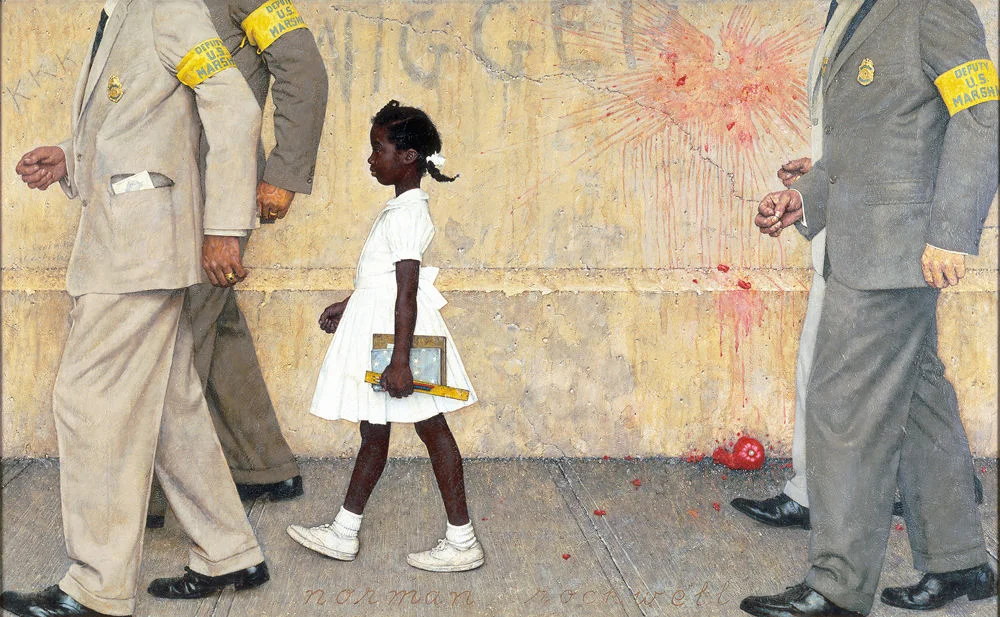Norman Rockwell 1894 - 1978
By Aliza Wall
Norman Rockwell, The Problem We All Live With, 1964, oil on canvas, 91 cm × 150 cm, Norman Rockwell Museum, https://upload.wikimedia.org/wikipedia/en/e/ed/The-problem-we-all-live-with-norman-rockwell.jpg.
Although not typically considered a member of the canon of “serious” artists; American author, painter, and illustrator Norman Rockwell served as an artistic documenter of American life and culture. Born on February 3, 1894, in New York City, Rockwell engaged himself in the arts from a young age. At age 14, Rockwell enrolled in The Chase School of Art and two years later enrolled in The National Academy of Design. Soon after, he transferred to The Arts Student League. As a student, Rockwell enjoyed success illustrating young people's magazines such as Boys Life, the official publication of the Boy Scouts of America. At this point in his career, Rockwell had already developed his nostalgic, Americana style.
At 21, Rockwell's family moved to New Rochelle, New York. Rockwell shared a studio with cartoonist Clyde Forsythe and, with his help, went on to produce work for magazines such as Life, Literary Digest, and Country Gentlemen. At just 22, Rockwell painted his first cover for The Saturday Evening Post entitled Mother’s Day Off, a painting poking fun at a man pushing a stroller on Mother’s Day. The figures in this painting are emblematic of those who would feature in Rockwell’s subsequent 321 Post covers. They are round and almost cherubic, an icon of the "American" man.
Rockwell's career reached its peak during World War II, perhaps culminating specifically in his series, Four Freedoms. The series is comprised of the paintings Freedom of Speech, Freedom to Worship, Freedom from Want, and Freedom from Fear, each of which corresponded with an essay by a contemporary writer. The series essentially compels American support of World War II by evoking and idealizing the freedoms that were at stake if America was to lose the War. Due to its popularity, the series toured the United States in an exhibition sponsored by the Post and the U.S. Treasury Department. The exhibition raised more than $130 million (approximately £98 million) for the war effort. Although Rockwell was undeniably successful, he was scorned by art critics like Clement Greenberg, who claimed that Rockwell deserved to be put "down below the rank of minor artists" because of his choice to depict idealised, everyday scenes.
Rockwell became far less enchanted with an idealised, homogenous America during the 1960s and 70s. Of his more critical paintings and covers, Rockwell said, "I get an uncontrollable urge to say something serious." This social consciousness can be seen in his acclaimed painting, The Problem We All Live With (1964). The piece depicts six-year-old Ruby Bridges, the first African-American child to desegregate an elementary school in Louisiana. She is accompanied by a team of U.S. Marshals and surrounded by thrown vegetables and racial slurs. The image centres on Bridges, highlighting both her bravery and isolation in an unimaginably hostile situation. Rockwell's fame granted him a captive audience, allowing him to share an incredibly pivotal moment in history, even with those who may have opposed it. The painting remains impactful; it was displayed in the White House in 2011 at the request of former president Barack Obama.
In 1977, Rockwell was awarded the Presidential Medal of Freedom by President Ford for "vivid and affectionate portraits of our country." Just a year later, Rockwell died of emphysema in his home. Rockwell's legacy persists to this day, continuing to serve as an emblem of American society, whether it be the nostalgic past or the progressive future.
Bibliography
Gotthardt, Alexxa. “Why Norman Rockwell Matters.”Artsy. 1 June 2018. https://www.artsy.net/article/artsy-editorial-norman-rockwell-matters.
Jegede, Abisola. “Norman Rockwell and Race: Complicating Rockwell’s Legacy.” Washington University in St. Louis University Libraries. 22 November 2016. https://library.wustl.edu/norman-rockwell-race-complicating-rockwells-legacy/.
“Norman Rockwell- A Brief Biography.” Norman Rockwell Museum. Accessed 28 January 2018. https://www.nrm.org/about/about-2/about-norman-rockwell/.

